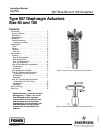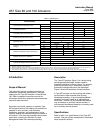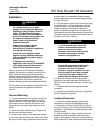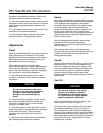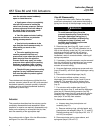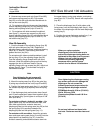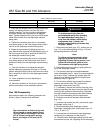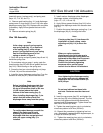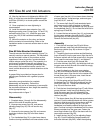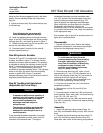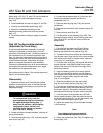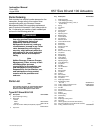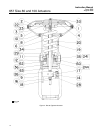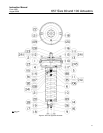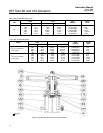
657 Size 80 and 100 Actuators
Instruction Manual
Form 1909
August 2006
4
is properly connected to the actuator. Refer to the
positioner instruction manual as necessary.
4. Cycle the actuator several times to check that the
valve stem travel is correct and that the travel occurs
when the correct pressure range is applied to the
diaphragm.
5. If valve stem travel is incorrect, refer to the Travel
procedure in the Adjustments section.
6. If the pressure range is incorrect, refer to the
Spring procedure in the Adjustments section.
Adjustments
Travel
Make travel adjustments when the motion observed
during actuator travel is different from the travel
stamped on the actuator nameplate. If the Actuator
Mounting procedure was followed correctly, this
adjustment should not be necessary.
When adjusting travel of a reverse-acting
(push-down-to-open) valve, apply a slight pressure
on the actuator diaphragm. This moves the valve
plug off the seat, reducing the chance of damaging
the valve plug or seat during adjustments.
1. Back the stem locknuts away from the stem
connector, and slightly loosen the stem connector
cap screws.
CAUTION
Do not use wrenches or other tools
directly on the valve stem. Damage to
the stem surface and subsequent
damage to the valve packing may
result.
2. Tighten the locknuts together, using a wrench,
then screw the valve stem either into the stem
connector to lengthen travel or out of the stem
connector to shorten travel.
3. Cycle the actuator to check the travel. If actual
travel is not equal to the specified travel, adjust and
check travel until correct. Tighten the stem
connector cap screws when correct travel is
obtained.
4. Raise the travel indicator disk by threading the
stem locknuts against the stem connector.
Spring
Make spring adjustments when the loading pressure
range applied to achieve specified travel is not equal
to the pressure range stamped on the actuator
nameplate. Refer to the Bench Set pressure range
on the nameplate when the valve contains no
pressure and the packing is loosely inserted in the
bonnet. Refer to the Max. Allow. Supply on the
nameplate when the valve is controlling the specified
pressure drop and the packing is tightened to stop
leaks around the stem.
Monitor loading pressure carefully when making
adjustments. Do not exceed the pressure
specifications of either the loading regulator or the
actuator casings.
Each actuator spring has a fixed pressure span.
Changing the spring compression shifts the span up
or down to make valve travel coincide with the
loading pressure range.
Size 80
Remove cover band (key 60, figure 4), insert a rod of
approximately 12.7 mm (1/2-inch) diameter into a
hole in the adjusting screw (key 12, figure 4), and
rotate the adjusting screw with the rod. Rotating the
screw from left to right will increase the loading
pressure required to start actuator stem travel;
opposite rotation will decrease the pressure required
to start travel.
Size 100
CAUTION
The actuator must be in the vertical
position when adjusting spring to
avoid damage to thrust bearing (key
35, figure 5) and to properly position
spacers required for adjustment.
Remove the shroud plate (key 107, figure 5), and
loosen the jam nut (key 115, figure 5).
For small spring forces, adjustments can be made
by rotating the adjusting nut (key 114, figure 5).
Clockwise rotation (when viewed from diaphragm
casings) of the adjusting nut will increase the loading
pressure required to start actuator stem travel, and
counterclockwise rotation will decrease the pressure
required to start travel. Tighten the jam nut when
adjustment is complete.



